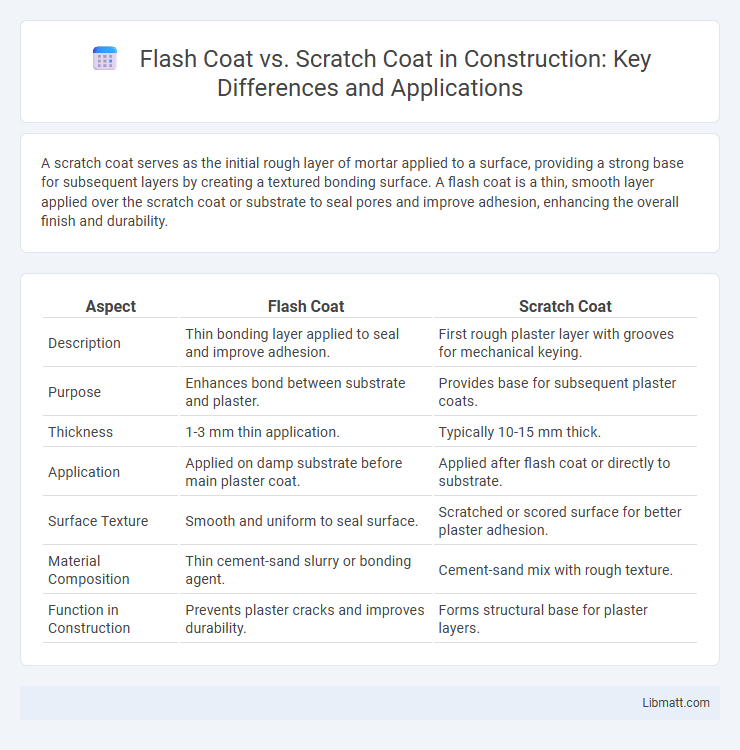A scratch coat serves as the initial rough layer of mortar applied to a surface, providing a strong base for subsequent layers by creating a textured bonding surface. A flash coat is a thin, smooth layer applied over the scratch coat or substrate to seal pores and improve adhesion, enhancing the overall finish and durability.
Table of Comparison
| Aspect | Flash Coat | Scratch Coat |
|---|---|---|
| Description | Thin bonding layer applied to seal and improve adhesion. | First rough plaster layer with grooves for mechanical keying. |
| Purpose | Enhances bond between substrate and plaster. | Provides base for subsequent plaster coats. |
| Thickness | 1-3 mm thin application. | Typically 10-15 mm thick. |
| Application | Applied on damp substrate before main plaster coat. | Applied after flash coat or directly to substrate. |
| Surface Texture | Smooth and uniform to seal surface. | Scratched or scored surface for better plaster adhesion. |
| Material Composition | Thin cement-sand slurry or bonding agent. | Cement-sand mix with rough texture. |
| Function in Construction | Prevents plaster cracks and improves durability. | Forms structural base for plaster layers. |
Introduction to Flash Coat and Scratch Coat
Flash coat is a thin layer of mortar applied to a rough concrete or masonry surface to create a smooth, even base for finishing materials, enhancing adhesion and appearance. Scratch coat, typically thicker, serves as the initial rough layer in plastering or stucco work, providing structural support and a textured surface for subsequent coats to bond securely. Understanding the differences between your flash coat and scratch coat ensures optimal preparation and durability in construction and renovation projects.
Understanding the Purpose of Each Coat
Flash coat provides a thin, smooth layer designed to fill minor surface imperfections and create a uniform base for subsequent finishes. Scratch coat serves as the foundational layer in plaster or stucco application, featuring a rough texture to ensure mechanical bonding with the next coat. Understanding the purpose of each coat helps you achieve optimal adhesion and surface quality in your wall treatments.
Key Differences Between Flash Coat and Scratch Coat
Flash coat is a thin, quick-setting layer applied to level irregularities on masonry surfaces, while scratch coat is a thicker, rough-textured base applied to provide a strong adhesion surface for subsequent plaster layers. Flash coat typically helps in minor surface corrections, whereas scratch coat establishes structural bonding and durability in plaster systems. Understanding these differences ensures your plaster work achieves optimal strength and finish quality.
Common Materials Used in Flash and Scratch Coating
Flash coat and scratch coat both utilize cement, sand, and water as primary materials, but the flash coat often incorporates finer aggregates and bonding agents to create a smooth, adhesive layer. Scratch coat typically includes coarser sand to provide a rough texture that promotes better adhesion for the subsequent layers. Your choice between these coatings depends on the surface requirements and the desired finish quality.
Application Processes Compared
Flash coat application involves quickly applying a thin, smooth layer of plaster or mortar to repair or prepare uneven surfaces, enhancing adhesion for subsequent layers. Scratch coat is the first layer of a multi-coat plaster system, applied thicker and scored or scratched to create a rough surface for better bonding with the brown or finish coat. While flash coats address localized surface imperfections, scratch coats provide structural base support essential for multi-layered plaster installations.
Advantages of Flash Coat
Flash coat offers rapid drying times and excellent adhesion, making it ideal for quick repairs and preparing surfaces for final finishing layers. Its thin, smooth application minimizes material waste while effectively sealing porous substrates and creating a uniform base. Flash coat enhances durability and reduces the likelihood of cracking compared to traditional scratch coats, improving overall surface integrity.
Benefits of Scratch Coat
A scratch coat provides a strong, rough base layer that improves adhesion for the subsequent plaster or stucco layers, enhancing overall durability and preventing cracks. This initial layer helps create a uniform surface that supports better bonding and moisture resistance, ensuring longer-lasting results. Its textured finish also acts as a mechanical key that increases the structural integrity of the entire wall system.
Usage Scenarios: When to Use Each Coat
Flash coat is used to quickly smooth rough masonry surfaces, ideal for preparing walls before applying a final finish or paint, especially on uneven or porous substrates. Scratch coat serves as the foundational layer in plaster or stucco systems, applied to provide adhesion and a key for subsequent layers, typically used on new construction or repair work requiring structural strength. Select a flash coat to achieve surface uniformity and a scratch coat to establish a strong base for multi-layer plaster applications.
Best Practices for Achieving Optimal Results
Flash coat and scratch coat are critical steps in plaster application that ensure strong adhesion and a smooth finish. Applying the scratch coat first creates a rough surface, improving bond strength, while the flash coat seals pores and evens out absorption rates, preventing cracks. To achieve optimal results, you should maintain proper curing times, use consistent mixing ratios, and apply each coat at the recommended thickness for maximum durability and finish quality.
Conclusion: Choosing the Right Coat for Your Project
Flash coat provides a smooth, even surface ideal for finishing or repairing small imperfections, while scratch coat creates a rough texture to enhance bond strength for subsequent layers. Your project requirements determine the best choice: use a flash coat for a refined appearance and a scratch coat when strong adhesion is essential. Selecting the right coat ensures durability and a professional finish tailored to your construction or repair needs.
Flash coat vs scratch coat Infographic

 libmatt.com
libmatt.com